
10 English Cottage Garden Ideas
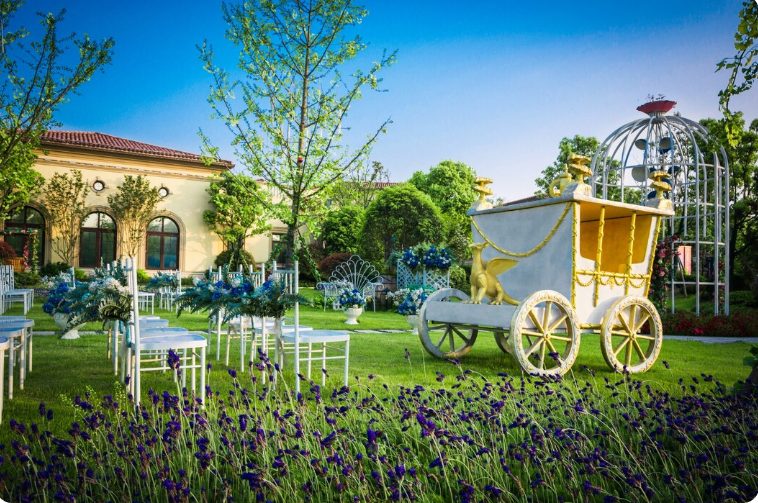
Old stone paths. Bunches of roses. Vines climbing up wooden fences. An English cottage garden feels peaceful and full of life. It brings charm to small yards, front porches, and backyard corners.
The mix of flowers, herbs, and soft shapes creates a space that feels like a storybook. These gardens don’t follow rules. Wildflowers bloom next to vegetables.
Lavender stands beside roses. It all blends together in a beautiful, easy way. No need for straight lines or perfect rows. Just color, texture, and soft paths underfoot. English cottage gardens invite butterflies, birds, and bees.
They grow in every corner. With just a few tools and some care, anyone can build a space like this. Every idea in this list adds a little magic. Some ideas use old items you already have. Others just need a few plants and a plan. Start small and let your garden grow with love.
10 English Cottage Garden Ideas
A cottage garden feels like a dream. Wild, colorful, and full of life. This style brings nature close and keeps everything soft and welcoming. You don’t need fancy designs or expensive materials.
The magic lives in simple touches and natural beauty. Think flowers spilling over paths, old fences covered in vines, and small corners filled with charm. Let’s explore 10 English cottage garden ideas that can turn your outdoor space into a peaceful escape.
1. Mix Flowers in Every Color
Cottage gardens never follow strict color rules. Red, yellow, pink, blue—they all bloom together. This mix makes the garden feel alive. Tall flowers rise in the back, short ones stay near the front. Plant them close, so there are no empty spaces. The goal is a full, rich look.
Some classic flowers:
-
Hollyhocks
-
Delphinium
-
Foxglove
-
Daisies
-
Roses
-
Lavender
This mix attracts bees and butterflies too. More life means more joy in the garden.
2. Use Curved Paths

Straight lines feel modern. Curves feel soft and natural. A winding path invites people to walk slow and enjoy the view. Gravel or stepping stones work best. They look old-fashioned and match the cottage feel.
Let flowers spill onto the path edges. It blurs the lines and adds charm. Paths don’t have to lead anywhere big—just a bench, a gate, or a birdbath.
3. Add a Classic White Picket Fence

Nothing says cottage garden like a white picket fence. It’s charming and simple. It doesn’t hide the garden. Instead, it frames it.
Let climbing flowers grow up the fence. Roses, sweet peas, or clematis work well. They soften the fence and make it feel part of the garden.
Old or slightly worn fences add even more character. Perfection is not the goal—personality is.
4. Grow Climbing Plants and Vines

Vertical space brings another layer to the garden. Use walls, arches, and trellises. Climbing plants take over and create a secret-garden feel.
Great climbers include:
-
Wisteria
-
Honeysuckle
-
Clematis
-
Climbing roses
Place an arch over the path. It feels like walking into a storybook. Even a simple wall can become beautiful with the right vine.
5. Fill Pots with Flowers and Herbs
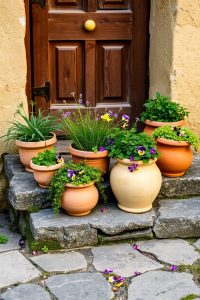
Not all gardens need large beds. Pots offer color and fragrance too. Use them near doors, windows, and on steps. They bring the garden closer.
Use old buckets, clay pots, or wooden boxes. Mix herbs like thyme, mint, and rosemary with small flowers. The smell and look are both lovely.
Group different pot sizes for a layered look. Keep them full and never empty.
6. Let Wildflowers Grow

Wildflowers bring charm without trying too hard. They need little care and fill space fast. Their soft look matches the relaxed cottage feel.
Scatter seeds in open spots. Let them find their way. Bees and birds love them too. Some great choices include:
-
Poppies
-
Cornflowers
-
Daisies
-
Yarrow
These flowers don’t need perfect soil or perfect lines. They grow wild and free.
7. Add Garden Décor with Personality

Cottage gardens feel personal. Old tools, birdhouses, and rustic benches fit right in. Nothing too shiny or new. The goal is comfort and charm.
Ideas to try:
-
A weathered wooden bench
-
An old watering can as a flower pot
-
A small statue under a tree
-
A birdbath in the center
Each piece adds a story. Keep it simple and meaningful.
8. Include a Vegetable or Herb Patch
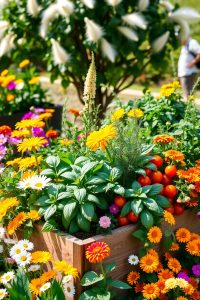
Cottage gardens often mix beauty with purpose. Food and flowers can grow side by side. A small veggie patch fits the idea well.
Raised beds or even old crates can hold lettuce, tomatoes, or beans. Herbs grow well around the edges. They smell great and help in cooking too.
This mix of beauty and use feels real and natural. It adds soul to the garden.
9. Use Soft Lighting
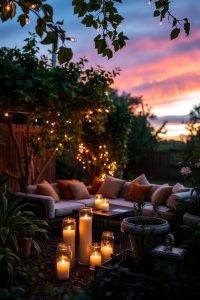
Gardens don’t stop being lovely at sunset. Lights make them magical. Soft, warm light adds comfort and a peaceful mood.
Try solar lanterns, string lights, or candles in jars. Place them along paths, on fences, or near seats.
Keep the light gentle. The goal isn’t to light up everything. Just enough to guide and glow.
10. Keep It Full and Slightly Wild
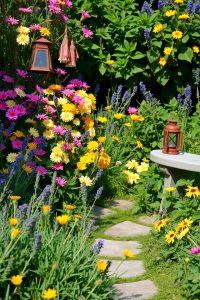
The real charm of a cottage garden lies in its fullness. No empty soil. No clean lines. Everything grows together and flows freely.
Mix heights. Let tall flowers lean. Let ground cover spill over borders. Use narrow spaces and corners. Let the garden feel alive and full of surprises.
Don’t pull every weed. Don’t trim every edge. Nature works best with a little freedom.
FAQs
What is the main idea behind an English cottage garden?
It’s about a natural, free-flowing garden with lots of flowers, personal touches, and a cozy feel. It looks full, colorful, and welcoming.
Can I grow vegetables in a cottage garden?
Yes. Mixing vegetables and herbs with flowers fits perfectly in a cottage-style garden. It adds use and beauty together.
How much space do I need for a cottage garden?
You don’t need a big yard. Even a small space, balcony, or patio can feel like a cottage garden with pots, flowers, and simple touches.
Are cottage gardens hard to maintain?
They need regular care, like watering and cutting back flowers. But they’re not strict. Wildness is part of the charm.
Which flowers are best for cottage gardens?
Classic choices include roses, hollyhocks, foxgloves, daisies, and lavender. These grow well together and match the soft, full look.
Conclusion
Cottage gardens bring peace, beauty, and warmth to any space. They don’t follow strict rules. They welcome nature in all its colors and shapes. Each plant, path, and pot adds to the story. There’s no need for perfect lines or expensive tools. Just a love for simple beauty and a bit of care.
Start small. One flower bed. One curved path. A few pots by the door. Let the garden grow over time, just like the charm it brings.
Your own slice of countryside life can begin right outside your window. And it doesn’t take much. Just a little space. A few seeds. And a heart for beauty. Because that’s what makes an English cottage garden feel like home.

